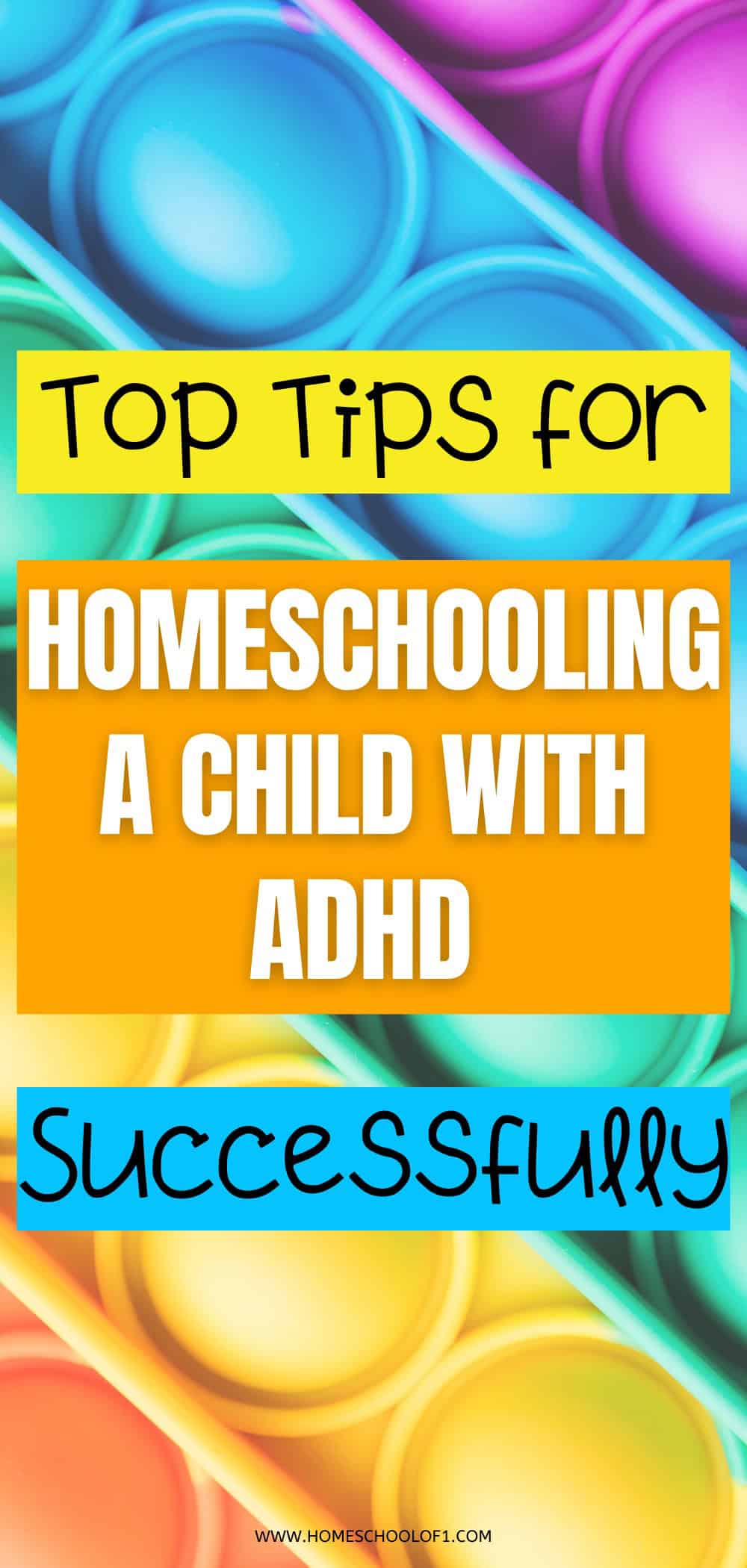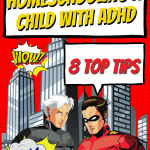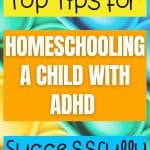Top Tips for Homeschooling a Child with ADHD Successfully
Tips for homeschooling a child with ADHD start with understanding the unique needs and challenges posed by attention deficit hyperactivity disorder.
Finding the best homeschool curriculum for ADHD can be a game-changer, providing the right balance of flexibility and support.
Homeschooling offers a unique opportunity to tailor education to your child’s specific needs, allowing for adjustments that a traditional classroom setting might not accommodate. With the right strategies and resources, you can create a nurturing and effective learning environment.
In this article, we’ll explore practical tips for homeschooling children with ADHD, curated to address their unique challenges and strengths.
From creating a structured learning environment to incorporating physical activities and leveraging technology, these strategies will help you and your child navigate the homeschooling journey with confidence.

**This post may contain affiliate links. As an Amazon Associate and a participant in other affiliate programs, I earn a commission on qualifying purchases.**
Understanding ADHD in Children
Attention Deficit Hyperactivity Disorder (ADHD) is characterized by symptoms of inattention, hyperactivity, and impulsivity.
Children with ADHD may struggle with maintaining focus, sitting still, and controlling their impulses, which can interfere with their ability to learn in traditional school environments.
Homeschooling can provide the flexibility and individualized attention they need to thrive.
Creating a Structured Learning Environment
1. Establish a Routine: Consistency is crucial for children with ADHD. Create a daily schedule that includes specific times for learning, breaks, meals, and physical activities. A predictable routine helps reduce anxiety and improves focus.
2. Designate a Learning Space: Set up a quiet, clutter-free area dedicated to schoolwork. Find the best school supplies for ADHD to minimize distractions and signal to your child that it’s time to focus.
Adapting Teaching Methods
3. Use Multi-Sensory Techniques: Incorporate visual aids, hands-on activities, and auditory instructions to cater to different learning styles. Multi-sensory teaching can help children with ADHD grasp concepts more effectively.
4. Break Lessons into Chunks: Children with ADHD often have shorter attention spans. Divide lessons into smaller, manageable segments with breaks in between to keep them engaged.
5. Implement Movement Breaks: Frequent breaks for physical activity can help manage hyperactivity. Simple exercises, such as jumping jacks or a quick run around the yard, can help your child release excess energy and return to their work with better focus.
“Effective treatments and strategies, including structured and individualized educational approaches like homeschooling, can help manage symptoms of ADHD and improve daily functioning and relationships” (National Institute of Mental Health) (NIMH).
Utilizing Technology and Tools
6. Leverage Educational Apps: There are numerous apps designed to help children with ADHD. Tools like timers, reminder apps, and interactive learning games can make lessons more engaging and help with time management.
7. Use Assistive Technology: Consider software that aids in reading, writing, or organizing tasks. Tools like speech-to-text and text-to-speech can be particularly helpful for children with ADHD. These toys for kids with sensory issues can also be incorporated into your everyday learning.
Behavioral Strategies and Positive Reinforcement
8. Set Clear Expectations: Clearly define what is expected in terms of behavior and schoolwork. Use simple, concise instructions and visual schedules to reinforce expectations.
9. Use Positive Reinforcement: Reward systems can motivate children with ADHD. Praise, stickers, or a points system leading to a larger reward can reinforce good behavior and effort.
10. Practice Patience and Empathy: Understand that children with ADHD are not intentionally disruptive. Patience and empathy can go a long way in creating a supportive learning environment.
Incorporating Physical Activity
11. Daily Physical Exercise: Regular physical activity is essential. Exercise can improve concentration and reduce symptoms of ADHD. Incorporate activities like yoga, swimming, or even a family walk into your routine.
12. Active Learning: Combine learning with physical activity. For example, use a trampoline for spelling words or do math problems with a hopscotch game. This approach can make learning more dynamic and enjoyable.
Socialization and Support
13. Arrange Social Activities: Homeschooling doesn’t mean isolation. Join homeschooling groups, sports teams, or community activities to ensure your child has opportunities to interact with peers.
14. Seek Support: Connect with other parents of children with ADHD. Support groups can provide valuable advice, resources, and emotional support.
Tailoring Curriculum and Goals
15. Customize Curriculum: Choose or design a curriculum that plays to your child’s strengths and interests. A personalized approach can make learning more engaging and effective.
16. Set Realistic Goals: Set achievable, short-term goals to help your child experience success and build confidence. Break larger tasks into smaller, more manageable steps.
17. Unschooling ADHD students can be a flexible and effective approach, allowing them to pursue their interests and learning at their own pace while accommodating their unique needs.
Check out the best math curriculum for ADHD
Managing ADHD Symptoms
18. Medication Management: If your child is on ADHD medication, ensure it’s taken consistently and discuss any concerns with your healthcare provider. Medication can significantly improve focus and behavior. Find natural ways to increase dopamine for ADHD, such as eating more protein.
19. Behavioral Therapy: Consider incorporating behavioral therapy into your homeschooling plan. Techniques from Cognitive Behavioral Therapy (CBT) can help your child develop coping strategies and improve self-control.
Promoting Independence and Self-Regulation
20. Teach Self-Regulation Skills: Help your child recognize their own signs of distraction or frustration and develop strategies to manage these feelings. Techniques such as deep breathing, mindfulness, or taking a brief timeout can be beneficial.
21. Encourage Independence: Gradually increase your child’s responsibility for their own learning. This can include setting personal goals, managing their schedule, or completing tasks with minimal supervision.

Addressing Coexisting Conditions
22. Monitor for Coexisting Conditions: Children with ADHD may have coexisting conditions like anxiety, depression, or learning disabilities. Be vigilant and seek professional help if you notice signs of other issues.
23. Integrate Therapies: If your child has multiple conditions, integrate different therapies. For example, speech therapy for language issues can be coordinated with your homeschooling efforts.
According to the Child Mind Institute, children who have ADHD tend to be highly intelligent and if their energy is well-focused, they go on to achieve great things in their lives.
Seeking Professional Guidance
24. Consult Health Professionals: Regular check-ins with your child’s pediatrician, psychiatrist, or psychologist can help manage ADHD symptoms effectively. They can provide valuable insights and adjustments to treatment plans as needed.

25. Educational Consultants: Consider hiring an educational consultant who specializes in ADHD. They can offer tailored advice and resources to optimize your homeschooling approach.
Discover the best ADHD books for parents and unlock your child’s potential!
Emphasizing Emotional Well-being
26. Build Self-Esteem: Children with ADHD often struggle with low self-esteem due to repeated challenges. Celebrate their achievements, no matter how small, and reinforce their strengths. These ADHD books for kids helped us no end.
27. Foster Open Communication: Maintain an open line of communication with your child. Encourage them to express their feelings and concerns, and listen actively to understand their perspective.
Flexibility and Adaptation
28. Be Flexible: Homeschooling allows you to be flexible with your approach. If a particular method isn’t working, don’t be afraid to try something new.
29. Adapt as Needed: As your child grows and their needs change, adapt your strategies. What works at one stage may need adjustment later on.

Embrace the Journey
Homeschooling a child with ADHD can be a rewarding journey filled with growth and learning for both you and your child.
By creating a structured yet flexible environment, utilizing diverse teaching methods, and fostering emotional well-being, you can help your child with ADHD thrive.
Remember, every child is unique, and finding what works best for your child will take time and patience. Embrace the process and celebrate the milestones along the way.
Incorporating organizational strategies for ADHD, such as using checklists, charts, and visual learning aids, can significantly enhance focus and task completion, thereby fostering an environment conducive to academic success for children with ADHD.
Last Updated on 10 April 2025 by Clare Brown


